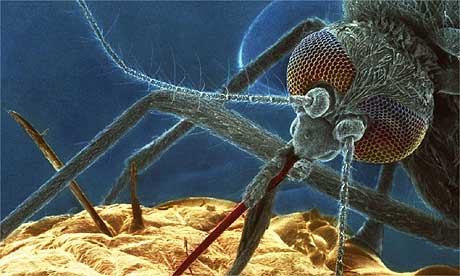 |
| female Anopheles mosquito |
Barring a thermonuclear crisis between Israel and Iran, 2012 may well go down as the year of the parasite. West Nile Virus put up strong numbers throughout the country and, only detected in 1999, was reported in 48 states and is here stay in the US. Bed bugs are becoming epidemic. Its also been a banner year for fleas and ticks, if you have pets you probably have noticed a higher than usual amount of parasite load on woofie and meow-meow this year. Simply put global warming is hastening the spread and proliferation of many parasites- particularly in the temperate to arctic latitudes. In the tropics, long a miasma of some of our most feared parasites and their diseases, its basically business as usual for parasites. But in areas that are having their winters cut short and summers extended parasitic bugs are waking up earlier and breeding more often throughout the year. And because these critters have such a high turnover rate and rapidity of generations compared to their host species- we can safely assume that they are evolving more quickly and adapting more rapidly to changing climatic schemes across the globe than their host. The parasite always wins.
A wealth of anecdotal reports is streaming in (see links in Pertinencia below) suggesting that shorter, warmer winters and longer and hotter summers are hastening tick outbreaks in moose populations- especially in the southern limits of the moose range. While many are crying foul and that these reports amount to nothing more than global warming propaganda, many of these reports are coming in from seasoned hunters/outdoorsmen- not your usual suspects when it come to environmental hyperbole. What they are finding paints a distressing and gruesome picture of an ecosystem in collapse.
 |
| Jerrold Masson (l) and father James Masson show off some bear chewed antlers. Jerrold and his father claim to have encountered unusually high numbers of tick killed moose in Maine |
"These are not winter kill" states lifelong outdoorsmen Jerrold Mason of Maine."Of the typical winter kill animals like moose it gets sick, it stands in a small area and basically you find 400 moose droppings and a dead moose in the middle of it." Freshly thawed out following the winter these moose are still covered in ticks and show no sign of predator kill or even scavenging, "The coyotes wouldn't eat them; the bears wouldn't eat them." Dubbing the dead adult moose and calves as "tick kills" Jerrod and his father and friends claim to have counted up to 60 dead moose where in the past they would normally find at most five winter killed moose.
The following pictures are from the hunters forum menoutdoors.com (lolzy name I know) http://www.menoutdoors.com/forums/showthread.php?t=9082 where a family came upon a moose in Nebraska so weakened from tick blood loss that they could readily approach the ailing herbivore- he even let his kids pet it (ewwww). The moose died the next day.
So what is it about the moose and this particular tick species- the winter tick- that allows these infestations to get so bad? Well here is a good write up on the intricate relationship between winter tick and moose. It turns out the name winter tick is an apt one because peak infestation and stress on the moose occurs in late winter/early spring during the months of March, April and early May. During this time the female ticks are schlurping up loads of blood in prep for egg laying (up to 100,000 winter ticks have been documented on a moose). The female ticks, after mating with smaller males, will drop off of the moose around this time and lay eggs in the leaf litter. This is a critical point in the cycle. If the snow pack is deep at this time of year the female ticks may die in the snow before they can safely lay their eggs- thus diminishing the amount of tick offspring that year, But if the snow is light or nonexistent then large amounts of winter tick are able to successfully lay eggs which ultimately lead to higher, and sometimes lethal, tick loads for the moose that season. Not enough late snow is bad news for moose pretty much.
Now just when you thought it was looking pretty grim for moose things appear to be getting worse for the largest cervid in the world. In addition to winter ticks, moose are now facing exotic lungworms from Europe that may represent the proverbial "nail in the coffin" for many moose populations.
 |
| Lungworm |
Well, that's enough grim news for now- I usually have a high threshold for this type of stuff but even I am getting a little bummed about the prospects of moose joining polar bears as potentially climate induced casualties of the anthropocene.
Coming up Battles in the North continued: Caribou and Mosquito
 |
| Infant displaying instinctive fear of Parasite Hilton |
Pertinencia
Death in the Woods
Global warming threatens wolves moose. science daily
Is Global Warming Nurturing Parasites?
Woodsmen, butchers say Maine moose, deer crawling with ticks
University of Maine tackles issue of lungworm in Moose



No comments:
Post a Comment